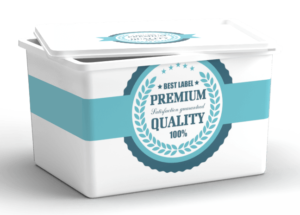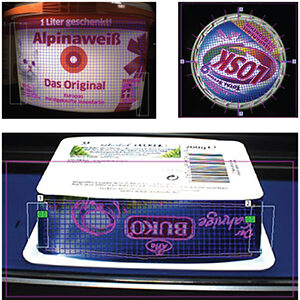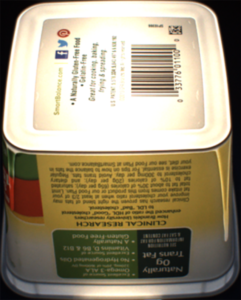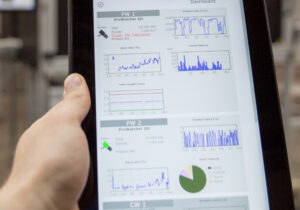by Scott Heins, director of sales and marketing, INTRAVIS Inc.

The market for in-mold-labeled (IML) packages continues to grow and expand domestically as well as internationally. IML decoration methods result in a customized, premium look that has always been preferred for high-end packages (see Figure 1). In recent years, this labeling technique has grown for traditional products, and even some commodity items, as manufacturers seek to differentiate themselves on store shelves full of an ever-diversifying range of products.
IML automation and the importance of a vision program
A major key for current and future growth of IML packages is automation, which enables cost-effective manufacturing to compete with traditionally cheaper decorating alternatives. Special consideration must be made for automated quality inspection – primarily machine vision systems – which is required to replace traditional manual inspection methods. Today’s vision technologies also can offer added value for process monitoring to prevent defects before they occur.
It is encouraged for manufacturers to implement a “vision program” to achieve consistent success in automation. While there are a number of highly skilled and capable IML automation companies, few have the capacity to offer a full range of vision technologies. Factors to consider when selecting a vision partner include:
- The range of experience for the specific application
- Ease of use for the technology offered
- Ability to create customized software and lighting solutions when needed, and
- The size and capacity to provide sufficient support for a technical product
- Capabilities of modern vision systems specialized for IML automation

While all vision systems will offer basic inspections for label presence and position, traditional technologies will fall short in consistent and comprehensive detection of defects within the label artwork. To overcome these limitations, INTRAVIS developed custom “surface evaluation” software (see Figure 2) that places an adaptive “grid” over the entire label surface to look for deviations. This “surface evaluation” inspection technique offers specific benefits for IML container inspection. One major benefit offered, in combination with lighting designed to highlight the defects, is reliable detection of “blow by” (see Figure 3). Additional defects this technique supports include label application defects, print errors or contamination.

Additional inspections specifically developed for IML container inspection include:
- Label joint defects for wrap-around labels
- Short shot detection on the seal surface of the injection molded container, and
- Reading of clear text codes (e.g., UFI and Batch Codes) in addition to the traditional barcode and 2D Matrix Code inspections
The importance of “ease-of-use”
While vision technologies offer ever-expanding capabilities, the benefits are rendered meaningless if the systems cannot be consistently set up and changed over by available manufacturing personnel. As a result, ease-of-use should be a major factor in selection of a partner for a vision program.
A clearly designed user interface allows easy navigation and intuitive groupings of statistics and product visuals. The operator saves an image of a single good product, called a “reference,” and works through a standardized guided set-up process. Software is designed to minimize and simplify the set-up steps for the specific application.
Process monitoring and industry 4.0

Today’s vision systems offer much more than the ability to reject defects. A key value that vision technology can offer is the ability to monitor the process to prevent defects from occurring in the first place. As factory automation is becoming increasingly machine-reliant, moving toward true “lights out” operation, vision technology becomes the “eyes of industry 4.0” to observe and monitor the performance of the production line (see Figure 4).
A fundamental capability to consider for process monitoring is the creation, display and communication of effective statistics and reports. Statistics should be grouped in an intuitive manner and should include graphical elements to visualize key data. Reports should include comprehensive counters and the ability to be transmitted to an external database as the customer requires.

Process monitoring can be enhanced significantly through the use of remote monitoring software. These are web-based programs accessible through a device such as a laptop, tablet or smartphone. Example features to utilize include customizable dashboards to view key statistics for each production line, trend monitoring tools and notifications. Software developed by INTRAVIS (see Figure 5), for example, will monitor key variables for upward or downward trends, e.g., values heading toward an upper or lower limit. When the software identifies a trend, it will calculate an estimated time to failure (ETF) and forward a notification to enable decision makers to act.
To summarize, automation including vision inspection is important for continued growth and expansion of in-mold-labeled packaging. For the best opportunity for success, it is recommended to partner with a vision system specialist as part of a vision program. Benefits that a partner can provide include better inspections, improved ease-of-use, extended statistics and reports and remote software for process monitoring. Application of an effective vision program will result in improved quality and prevention of defects before they even occur.
Scott Heins has 30 years of experience providing inspection solutions for the plastic packaging industry. He joined INTRAVIS in 2016 and is director of sales and marketing for the USA subsidiary located in Atlanta, Georgia. INTRAVIS is a market leader in design and manufacture of turnkey vision systems for plastic packaging including containers/bottles, decorations, closures and preforms. For more information, Heins can be reached at [email protected] or [email protected] or by visiting https://www.intravis.com/en/products/decoration-labeling/imlwatcher.


